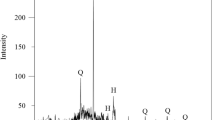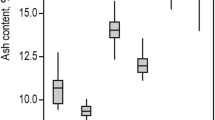Abstract
Alternative binders produced from waste for the stabilization of mining tailings (especially those considered hazardous) are important for waste management and sustainable engineering. Thus, this manuscript evaluated the leaching behavior of gold mining tailings stabilized/solidified by an alkali-activated binder (AAB) over wetting–drying cycles of durability test. The alternative binder is composed of sugarcane bagasse ash, carbide lime and sodium hydroxide. As a control group, the mining tailings were stabilized/solidified using Portland cement. In general, AAB showed favorable results in encapsulating Al, As, Ba, and Fe, while Portland cement exhibited effectiveness in the immobilization of Al, Ba, Fe, and Hg. For both AAB and Portland cement, higher dry unit weights and binder contents led to the encapsulation of metals in cemented mining tailings matrices. Samples with 30% AAB and 16.5 kN m−3 dry unit weight presented concentrations of Al, As, Ba, Cu, Fe, Hg, Se and Zn below the limits of all water standards. Alkali-activated binder from industrial waste was shown to be a new option to encapsulate contaminants from gold mining tailings.











Similar content being viewed by others
Data availability
The datasets generated during and/or analysed during the current study are available from the corresponding author on reasonable request.
References
Karaca O, Camaselle C, Reddy KR (2018) Mine tailing disposal sites: contamination problems, remedial options and phytocaps for sustainable remediation. Rev Environ Sci Biotechnol 17:205–228. https://doi.org/10.1007/s11157-017-9453-y
Bruschi GJ, dos Santos CP, de Araújo MT, Ferrazzo ST, Marques S, Consoli NC (2021) Green stabilization of bauxite tailings: a mechanical study on alkali-activated materials. J Mater Civ Eng 33(11):06021007. https://doi.org/10.1061/(ASCE)MT.1943-5533.0003949
Bruschi GJ, dos Santos CP, Ferrazzo ST, de Araújo MT, Consoli NC (2021) Parameters controlling loss of mass and stiffness degradation of green stabilized bauxite tailings. Proc Inst Civ Eng Geotech 19:1–21. https://doi.org/10.1680/jgeen.21.00119
Bruschi GJ, Fante F, de Tonini Araújo M, Dias Macedo G, Ruver CA (2021) Analysis of different failure criteria to evaluate bauxite tailings mechanical behavior through numerical modelling. Soils and Rocks 44:1–10. https://doi.org/10.28927/SR.2021.053720
Hatje V, Pedreira RMA, De Rezende CE, Schettini CAF, De Souza GC, Marin DC, Hackspacher PC (2017) The environmental impacts of one of the largest tailing dam failures worldwide. Sci Rep 7:10706. https://doi.org/10.1038/s41598-017-11143-x
Belle G, Fossey A, Esterhuizen L, Moodley R (2021) Contamination of groundwater by potential harmful elements from gold mine tailings and the implications to human health: a case study in Welkom and Virginia, Free State Province, South Africa. Groundw Sustain Dev 12:100507. https://doi.org/10.1016/j.gsd.2020.100507
Pan Z, Zhang C, Li Y, Yang C (2022) Solidification/stabilization of gold ore tailings powder using sustainable waste-based composite geopolymer. Eng Geol 309:106793. https://doi.org/10.1016/j.enggeo.2022.106793
Desogus P, Manca PP, Orrù G, Zucca A (2013) Stabilization/solidification treatment of mining tailings using Portland cement, potassium dihydrogen phosphate and ferric chloride hexahydrate. Miner Eng 45:47–54. https://doi.org/10.1016/j.mineng.2013.01.003
Rachman RM, Bahri AS, Trihadiningrum Y (2018) Stabilization and solidification of tailings from a traditional gold mine using Portland cement. Environ Eng Res 23(2):189–194. https://doi.org/10.4491/eer.2017.104
Consoli NC, Vogt JC, Silva JPS, Chaves HM, Scheuermann Filho HC, Moreira HB, Lotero A (2022) Behaviour of compacted filtered iron ore tailings–portland cement blends: new brazilian trend for tailings disposal by stacking. Appl Sci 12:836. https://doi.org/10.3390/app12020836
Garcia-Lodeiro I, Palomo A, Fernández-Jiménez A (2015) An overview of the chemistry of alkali-activated cement-based binders. In: Pacheco-Torgal F, Labrincha JA, Leonelli C, Palomo A, Chindaprasirt P (eds) Handbook of alkali-activated cements, mortars and concretes. Woodhead Publishing, Sawston, pp 19–47
Miller SA, Myers RJ (2020) Environmental impacts of alternative cement binders. Environ Sci Technol 54:677–686. https://doi.org/10.1021/acs.est.9b05550
Queiróz LC, Dias Miguel G, Bruschi GJ, Deluan MSL (2022) Macro–micro characterization of green stabilized alkali-activated sand. Geotech Geol Eng 40:3763–3778. https://doi.org/10.1007/s10706-022-02130-9
Queiróz LC, Batista LLS, Souza LMP, Lima MD, Danieli S, Bruschi GJ, Bergmann CP (2022) Alkali-activated system of carbide lime and rice husk for granular soil stabilization. Proc Inst Civ Eng Gr Improv 21:1–37. https://doi.org/10.1680/jgrim.21.00048
Provis JL (2018) Alkali-activated materials. Cem Concr Res 114:40–48. https://doi.org/10.1016/j.cemconres.2017.02.009
Kiventerã J, Lancellotti I, Catauro M, Dal Poggetto F, Leonelli C, Illikainen M (2018) Alkali activation as new option for gold mine tailings inertization. J Clean Prod 187:76–84. https://doi.org/10.1016/j.jclepro.2018.03.182
Cristelo N, Coelho J, Oliveira M, Consoli NC, Palomo A, Fernández-Jiménez A (2020) Recycling and application of mine tailings in alkali-activated cements and mortars—Strength development and environmental assessment. Appl Sci 10:2084. https://doi.org/10.3390/app10062084
Pereira dos Santos C, Bruschi GJ, Mattos JRG, Consoli NC (2022) Stabilization of gold mining tailings with alkali-activated carbide lime and sugarcane bagasse ash. Transp Geotech 32:100704. https://doi.org/10.1016/j.trgeo.2021.100704
Ferrazzo ST, Tonini de Araújo M, Bruschi GJ, Korf EP, Levandoski WMK, dos Santos CP, Consoli NC (2023) Metal encapsulation of waste foundry sand stabilized with alkali-activated binder: batch and column leaching tests. J Environ Manage 348:119287. https://doi.org/10.1016/j.jenvman.2023.119287
Spreadbury CJ, Clavier KA, Lin AM, Townsend TG (2021) A critical analysis of leaching and environmental risk assessment for reclaimed asphalt pavement management. Sci Total Environ 775:145741. https://doi.org/10.1016/j.scitotenv.2021.145741
Bruschi GJ, dos Santos CP, Levandoski WMK, Ferrazzo ST, Korf EP, Saldanha RB, Consoli NC (2022) Leaching assessment of cemented bauxite tailings through wetting and drying cycles of durability test. Environ Sci Pollut Res 29:59247–59262. https://doi.org/10.1007/s11356-022-20031-5
Levandoski WMK, Ferrazzo ST, Bruschi GJ, Consoli NC, Korf EP (2023) Mechanical and microstructural properties of iron mining tailings stabilized with alkali-activated binder produced from agro-industrial wastes. Sci Rep 13:15754. https://doi.org/10.1038/s41598-023-42999-x
Sá TSW, Oda S, Balthar VKCBLM, Toledo Filho RD (2022) Use of iron ore tailings and sediments on pavement structure. Constr Build Mater 342:128072. https://doi.org/10.1016/j.conbuildmat.2022.128072
ABNT (2004a) Resíduos sólidos—Classificação. ABNT NBR 10004. Rio de Janeiro, BR
ABNT (2004b) Lixiviação de Resíduos—Procedimento. ABNT NBR 10005. Rio de Janeiro, BR
ABNT (2004c) Solubilização de Resíduos—Procedimento. ABNT NBR 10006. Rio de Janeiro, BR
Ladd RS (1978) Preparing test specimens using undercompaction. Geotech Test J 1(1):16–23
ASTM (2015) Standard test methods for wetting and drying compacted soil-cement mixtures. ASTM D559/D559M. West Conshohocken, PA
EA (2004) Leaching characteristics—Determination of the leaching of inorganic components from moulded or monolitic materials with a diffusion test—Solid earthy and stony materials. NEN 7375
VROM (2000) Dutch target and intervention values. Ministerie van Volksuisveting Ruimtelijke Ordening en Milieubeheer. See https://www.esdat.net/environmental%20sta ndards/dutch/annexs_i2000dutch%20environmental%20standards.pdf (accessed 11/01/2021)
CONAMA (2013) Altera a Resolução no 420, de 28 de dezembro de 2009, do Conselho Nacional do Meio Ambiente-CONAMA, que dispõe sobre critérios e valores orientadores de qualidade do solo quanto à presença de substâncias químicas e dá outras providências. CONAMA Resolução 460. Official Diary of the Union
USEPA (2020) Ground water and drinking water: national primary drinking water regulations. See https://www.epa.gov/ground-water-and-drinking-water/national-primary-drinking-water-regulations#Inorg anic (accessed 11/01/2021)
Bye GC (1999) Portland cement composition: production and properties, 2nd edn. Thomas Telford Publishing, London
Mahedi M, Cetin B, Dayioglu AY (2019) Leaching behavior of aluminum, copper, iron and zinc from cement activated fly ash and slag stabilized soils. Waste Manag 95:334–355. https://doi.org/10.1016/j.wasman.2019.06.018
Mitchell JK, Soga K (2005) Fundamentals of soil behavior. John Wiley and Sons, New York
Tangviroon P, Endo Y, Fujinaka R, Kobayashi M, Igarashi T, Yamamoto T (2020) Change in arsenic leaching from silty soil by adding slag cement. Water Air Soil Pollut 231(6):259. https://doi.org/10.1007/s11270-020-04630-x
Ho GD, Tabelin CB, Tangviroon P, Tamamura S, Igarashi T (2021) Effects of cement addition on arsenic leaching from soils excavated from projects employing shield-tunneling method. Geoderma 385:114896. https://doi.org/10.1016/j.geoderma.2020.114896
Mahedi M, Cetin B, Dayioglu AY (2020) Effect of cement incorporation on the leaching characteristics of elements from fly ash and slag treated soils. J Environ Manage 253:109720. https://doi.org/10.1016/j.jenvman.2019.109720
Deja J (2002) Immobilization of Cr6+, Cd2+, Zn2+ and Pb2+ in alkaliactivated slag binders. Cem Concr Res 32:1971–1979. https://doi.org/10.1016/S0008-8846(02)00904-3
Lancellotti I, Barbieri L, Leonelli C (2015) Use of alkali-activated concrete binders for toxic waste immobilization. In: Pacheco-Torgal F, Labrincha JA, Leonelli C, Palomo A, Chindaprasirt P (eds) Handbook of alkali-activated cements, mortars and concretes. Woodhead Publishing, Sawston, pp 539–554
Eckbo C, Okkenhaug G, Hale SE (2022) The effects of soil organic matter on leaching of hexavalent chromium from concrete waste: batch and column experiments. J Environ Manage 309:114708. https://doi.org/10.1016/j.jenvman.2022.114708
Dermatas D, Moon DH (2006) Chromium leaching and immobilization in treated soils. Environ Eng Sci 23(1):77–87. https://doi.org/10.1089/ees.2006.23.77
Zhang WJ, Lin MF (2020) Influence of redox potential on leaching behavior of a solidified chromium contaminated soil. Sci Total Environ 733:139410. https://doi.org/10.1016/j.scitotenv.2020.139410
Özkök E, Davis AP, Aydilek AH (2013) Leaching of As, Cr, and Cu from high-carbon fly ash–soil mixtures. J Environ Eng 139(11):1397–1408. https://doi.org/10.1061/(ASCE)EE.1943-7870.0000751
Contessi S, Calgaro L, Dalconi MC, Bonetto A, Bellotto MP, Ferrari G, Marcomini A, Artioli G (2020) Stabilization of lead contaminated soil with traditional and alternative binders. J Hazard Mater 382:120990. https://doi.org/10.1016/j.jhazmat.2019.120990
Li YY, Zhang TT, Jia SB, Liu J, Quan XH, Zheng W (2019) Mechanical properties and leaching characteristics of geopolymer-solidified/stabilized lead-contaminated soil. Adv Civ Eng 2019:1–8. https://doi.org/10.1155/2019/6015769
Moon DH, Grubb DG, Reilly TL (2009) Stabilization/solidification of selenium-impacted soils using Portland cement and cement kiln dust. J Hazard Mater 168(2–3):944–951. https://doi.org/10.1016/j.jhazmat.2009.02.125
Brandely M, Coussy S, Blanc-Biscarat D, Gourdon R, Blanck G (2022) Chemical stabilization used to reduce geogenic selenium, molybdenum, sulfates and fluorides mobility in rocks and soils from the Parisian Basin. Environments 9(7):78. https://doi.org/10.3390/environments9070078
Cetin B, Aydilek AH, Guney Y (2012) Leaching of trace metals from high carbon fly ash stabilized highway base layers. Resour Conserv Recycl 58:8–17. https://doi.org/10.1016/j.resconrec.2011.10.004
Bestgen JO, Cetin B, Tanyu BF (2016) Effects of extraction methods and factors on leaching of metals from recycled concrete aggregates. Environ Sci Pollut Res 23(13):12983–13002. https://doi.org/10.1007/s11356-016-6456-0
Funding
The present work was supported by CNPq - Conselho Nacional de Desenvolvimento Científico e Tecnológico – Brazil. The authors also wish to express their gratitude to MEC-CAPES, FAPERGS/CNPq December 2014 – PRONEX (Project # 16/2551-0000469-2), and MCT-CNPq (Editais INCT-REAGEO, Universal & Produtividade em Pesquisa) for supporting the research group.
Author information
Authors and Affiliations
Contributions
All authors contributed to the study conception and design. Material preparation, data collection and analysis were performed by CPdS, GJB, STF, and WMKL. The first draft of the manuscript was written by Carolina Pereira dos Santos and all authors commented on previous versions of the manuscript. All authors read and approved the final manuscript. In addition, EPK, and NCC were also responsible for the supervision.
Corresponding author
Ethics declarations
Conflict of interests
The authors declare that they have no conflict of interest.
Additional information
Publisher's Note
Springer Nature remains neutral with regard to jurisdictional claims in published maps and institutional affiliations.
Rights and permissions
Springer Nature or its licensor (e.g. a society or other partner) holds exclusive rights to this article under a publishing agreement with the author(s) or other rightsholder(s); author self-archiving of the accepted manuscript version of this article is solely governed by the terms of such publishing agreement and applicable law.
About this article
Cite this article
Pereira dos Santos, C., Bruschi, G.J., Tonatto Ferrazzo, S. et al. Leaching Behavior of Alkali-Activated Gold Tailings Over Wetting–Drying Cycles. Indian Geotech J (2024). https://doi.org/10.1007/s40098-024-00886-w
Received:
Accepted:
Published:
DOI: https://doi.org/10.1007/s40098-024-00886-w




